Tooth extraction
Years ago, the only answer to any toothache was to pull the whole tooth out. Thankfully, that rather brutal approach is now behind us.
There are many clever, innovative and modern solutions for damage which can be used to repair and save your teeth. And we'll do all we can to make sure that tooth extraction is the last option we explore with you. Sadly though, sometimes, damage or decay is just too severe and the best thing for the overall health of your mouth is to remove the offending tooth.
A number of factors can bring a tooth to this very poor condition; impact damage, extreme decay, infection that can’t be cured with root canal treatment and/or antibiotics, or disease of the surrounding gum tissue are perhaps the most common.
So, if you and your Clinic 95 dentist decide that the best course of action is to remove your problem tooth, what exactly happens?
Tooth extraction safety
Before we commence the tooth extraction procedure itself, we'll take a very detailed medical history from you, which will include all kinds of information that you might not usually associate with your oral health. This will include details of what medications you're taking, questions about your immune system, and your history of major operations, such as heart surgeries or joint replacements. This is because very occasionally, having a tooth taken out can release bacteria into the bloodstream that may cause an infection, which can be problematic for patients with certain medical conditions. So we'll always check through your medical history in detail (and for those patients who have one or more of the risk factors, we may suggest a pre-treatment course of antibiotics to better prepare your system for the extraction).

Did you know..?
Queen Elizabeth 1 had rather decayed, black teeth. When she inevitably needed to have a tooth removed, she made an archbishop have one of his own teeth removed first to prove the procedure was safe for her. Charming.
Tooth extraction procedure
The most important thing for us to ensure is that you feel no pain during the tooth extraction procedure itself. So we'll numb the area with an anaesthetic injection first. As always, for very nervous or phobic patients, or for when the tooth extraction is more complex or involves the removal of more than one tooth, we will discuss the option of RA (relative analgesia) or IV sedation.
Once the area is completely numb, the tooth will be eased away from the bone of the jaw that has held it in place. Occasionally, this can involve moving the surrounding gum away from the tooth and can also require removing the tooth in several sections.
Tooth extraction pain
This procedure, although by its very nature invasive, is not painful. As described above, we will take very careful steps to ensure that you're sufficiently anaesthetised and if appropriate you may be sedated. You will however feel the pressure of the tooth being removed as the dentist may have to use considerable strength to achieve this. But apart from awareness of that pressure, you won't experience any pain.
However, pain following a tooth extraction is not uncommon and we have some aftercare guidance for you here.
Immediately after your tooth extraction
It's best not to eat or drink anything at all until the anaesthetic has completely worn off and you can feel the whole of your mouth, tongue and cheek(s) again. If you really can't wait, you must stick to cool liquid as you won't have enough sensation in your mouth to be able to tell the temperature of what you're drinking and so may inadvertently burn your mouth.
And of course, avoid chewing food in the area of the extraction.
Once the anaesthetic has worn off, any residual pain or discomfort can be easily addressed with pain medication. Please do not use aspirin, as this will interfere with the clotting process that is key to the healing of the extraction site. Instead use an ibuprofen-based pain reliever. However, these are not suitable for asthmatics – please ask us about pain relief if you suffer from asthma.
The first 24 hours after your tooth extraction
The initial healing in the 24hrs following the procedure is vital to the success of the extraction. You can help the healing process, by concentrating on keeping the extraction site as undisturbed as possible.
- Do not brush over the extraction site and avoid disturbing the site with your tongue.
- Do not chew in the area of the extraction.
- Do not drink alcohol and if possible, do not smoke.
- Do not undertake vigorous exercise, and do not participate in swimming, yoga or any activities in which the body is horizontal or the head is lower than the rest of the body. For example, it can help to sleep in a slightly more upright pose by adding an additional pillow to your normal sleeping position.
A little swelling and bleeding is normal following tooth extraction. But if you manage to follow the advice above, you will be helping to form a clot at the extraction site that will keep any bacteria or food debris out and create a clean, healing environment, free from infection.
Tooth extraction bleeding
You may notice a bit of bleeding after you've had a tooth extracted. This is normal, and may continue at a gentle pace for a few hours following the procedure, and at a low level for the first 24 hours.
As outlined above, please avoid the temptation to rinse the area. The extraction site is doing the most important of its healing work in the few hours after the procedure so you really mustn't disturb it by rinsing it or prodding it with your tongue.
However, you can deal with the bleeding by using a clean face cloth or cotton handkerchief folded to form a small pad and inserted in the mouth directly over the extract site. Bite down on this to apply pressure to the site as this will help to stem the bleeding and encourage a clot to form. Keep the pad securely in place for at least 15 minutes – the longer the better.
After 24 hours
Vigorous brushing over the extraction site still isn't recommended, but you can use a home-made mouth wash of a teaspoon of salt diluted in a glass of warm (not hot) water, to rinse the area with. This will help to clear it of any bits of food and will also help the healing process. Use this twice per day for a couple of days until you're confident that the area shows signs of being well healed (no bleeding, swelling or discomfort).
And because we're all different, make sure that at all times during and after a tooth extraction procedure, you follow the advice and guidance that your dentist gives you personally.
Tooth extraction complications
If after the first 24 hours following your procedure, you become concerned at the amount of bleeding, or if you experience any significant pain, please contact us immediately – this could be a sign of infection.
Also, you must call us urgently if you experience
- Nausea or vomiting
- Flu-like symptoms such as shivering or extreme fluctuations in your body temperature (feeling hot and cold)
- Very noticeable reaction in the extraction area such as redness, swelling, heavy bleeding, pus or discharge of any type
- Chest pain, shortness of breath or a sudden unexplained cough.
Any of these may be caused by an aggressive infection and need to be addressed urgently.
Tooth extraction healing time
If you've managed to keep the extraction site clean of food debris, have not chewed on or brushed over the area for the first few hours, have rinsed with salt water following that and have generally been taking good care of the site, your gums should heal in just a week or two.
After tooth extraction
And of course, once the procedure is performed and your mouth completely healed, you can turn your thoughts to how to fill the gap left by the removal of the old tooth. Although you can leave a gap, there is good reason to consider having it filled with a dental restoration that's not just about cosmetics.
Each tooth you have helps support the teeth on either side of it. Removing one, can cause the other teeth to shift, resulting in further compromised appearance and even bite problems. Your Clinic 95 dentist will explain all the options that are available ranging from the permanent (an implant), to the long term (a bridge), to the removable (a denture).
So tooth extraction is a fairly simple procedure that doesn't mean that you need to be left with a gap in your teeth.


